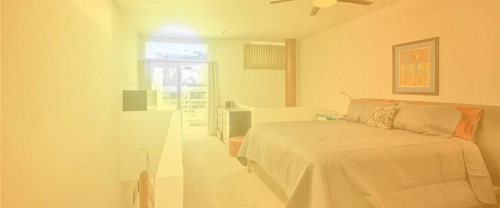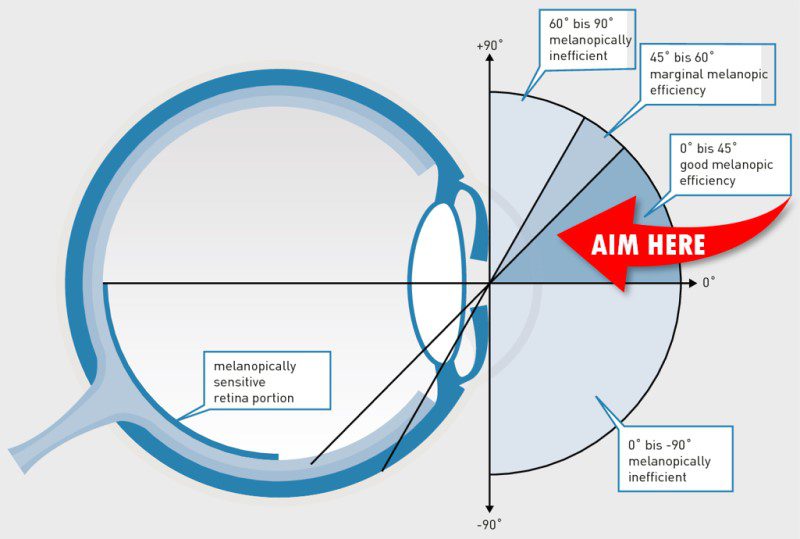
For optimal circadian stimulus in the morning, light should emanate from just above the horizon line because … Biophilia! (and photosensitive melanopsin)
10.11.19 – CEPro – Julie Jacobson
For circadian lighting, LED intensity and color temperature are just the beginning of the wellness story.
Typically, the smart-home industry refers to the control of lighting intensity and color temperature as key drivers for artificial daylighting — dimmer and warmer at dawn and dusk; brighter and cooler during the day — but it’s never that simple.
“True circadian lighting is challenging to achieve because it depends on so many external factors that are very difficult to control,” says Alessio Urso, a veteran lighting designer, home-technology integrator, and principal of the design firm LightSmarts, based in Alpharetta, Ga.
Lighting Strategies for Circadian Entrainment (Huh?)
For our purposes, “entrainment” refers to the simulation of natural cues, primarily lighting, for supporting our hard-coded circadian rhythms — our biological clocks. These rhythms are largely influenced by the same 24-hour day/night (diurnal) cycles that have continued over hundreds of thousands of years of evolution.
For almost all of that period, humans lived outdoors virtually 100% of the time, waking up with the sun and winding down at dusk. Since we spend 90% of our time indoors nowadays, we can use strategically tuned artificial lighting for circadian entrainment.
Absent natural daylight, so-called circadian lighting has been shown to improve sleep, moods, productivity and other health-and-wellness metrics.
While smart-home integrators are quickly educating themselves on the subject, and manufacturers have made great strides in simplifying the implementation of circadian lighting in the home, there’s no substitute for a lighting designer in developing the most effective lighting scheme for circadian entrainment.
Urso points to a number of considerations that can influence entrainment — in addition to lighting intensity (dim/bright levels) and color temperature (warm/cool hues measured in degrees Kelvin) — that they don’t usually teach in Circadian Lighting 101:
- Timing (time of day, transition timing)
- Light history (context, or historical exposure to light for any given party)
- Spatial distribution (direct/diffuse/directionality)
- Spectrum (akin to color temperature, but considers non-visual spectral wavelength for potentially greater biological impact)
Nuances of ‘Circadian Lighting’
Even with a Circadian Lighting Playbook, integrators will want to discuss “true” circadian lighting with a lighting designer.
For example, “Light color temperature can be shifted from warm to cool, and back to warm throughout the day,” Urso says, “but that will not help much if the spectrum is not appropriate.”
Not all 5000 Kelvin fixtures are the same, for instance, due in part to their varying spectral output, typically denoted by their color rendering index (CRI) score. Higher CRIs above 95 represent light spectrum closer to natural daylight, which by definition measures 100. (Purists will defer to the newer TM-30-18 technical memorandum from the Illuminating Engineering Society for improved color-rendering assessments, particularly for LEDs.)
Knowing these things is just the beginning, according to Urso. An effective lighting scheme should include a combination of direct and indirect lighting, wall sconces, floor lamps, natural daylight from windows (via motorized shade control and photosensors), and more.
Spatial distribution — the directivity and dispersion of lighting — can play a strong role in circadian entrainment, not to mention visual comfort.
“Lighting coming from above the horizon is best in the morning,” Urso says, “but typical downlights are not effective because our brow bone blocks most of the light that needs to go into the eye.”

The sweet spot for morning light is roughly 0 to 45 degrees above the horizon. At that angle, light hits photosensitive melanopsin cells in the retina, which are known to affect the secretion of melatonin, our natural sleep drug.
On the other hand, to induce melatonin secretion, an evening scene should exclude light from above the horizon as much as possible, and rely on table lamps, step lights, toe-kick illumination, and similar lower-level sources.
Light level typically should increase in the morning, and be at its highest between 9:00 a.m. and 1:00 p.m.
We should look no further than human evolution and the history of the world to recognize that our DNA revolves around the rising of the sun before the work day and the setting of the sun at bedtime. (Duh. Biophilia!)
And yet … would it occur to integrators to use different fixture types at different spatial levels to support natural circadian cycles?
“For circadian lighting to be most effective, it has to be coordinated between the lighting designer, interior designer, architect, and controls specialist,” Urso says.
*Image source: Inferior Retinal Light Exposure Is More Effective than Superior Retinal Exposure in Suppressing Melatonin in Humans
